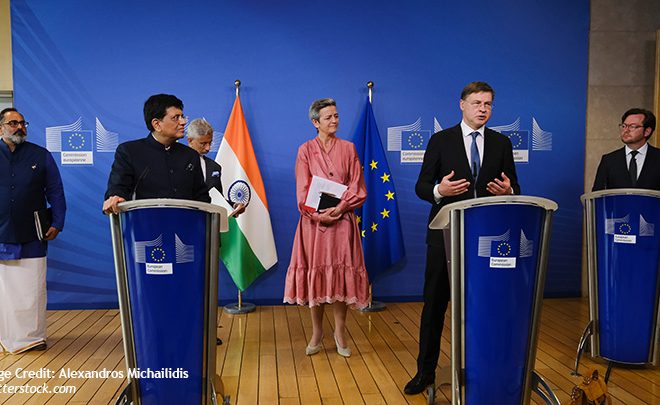India-EU Cooperation on Global Gateway can Check China’s BRI Strategy in the Himalayas

India and the EU enjoy close ties across diversified areas like trade, investments, defense cooperation, climate change, sustainable development and technological cooperation. The Global Gateway, an initiative that the EU launched in 2021 with an aim to participate in infrastructure development across the world, is likely to become one of the defining factors in India-EU relations.
This project is intended to mobilize €300 billion from its launch in 2021 until 2027 for connectivity projects, particularly in the digital, climate and energy, transport, health, education, and research sectors. Identifying the gap in global infrastructure, the World Bank has estimated a worldwide investment requirement of €1.3 trillion per year. Intending to address this infrastructure gap, China, through its Belt and Road Initiative (BRI) project, is expanding its strategic outreach around the world.
As China’s BRI is increasing strategic challenges for India in the neighborhood, cooperation with the EU could facilitate protection of India’s strategic interests as well as provide an alternative to the BRI. India-EU cooperation through the Global Gateway is concomitant to the India-EU Connectivity Partnership which was launched in 2021, the same year that the Global Gateway was launched.
Infrastructure Development in the Himalayas
In particular, India and the EU need to focus on engaging in infrastructure development in the Himalayas which would be important from three perspectives.
First, such cooperation could support India’s efforts to counter Chinese aggression on the India-China border. The decades-old border dispute between India and China has intensified in the past two years with the situation deteriorating in 2020 due to a clash between the militaries of the two countries at Galwan Valley in Ladakh in India. As the border stand-off between India and China has continued with no immediate resolution in sight, China has continued to raise the tension along the Line of Actual Control (LAC) with greater deployment of troops and also by deploying J-20 stealth fighters. Knowing that China’s assertion requires a concerted response, India has been engaging with like-minded countries through bilateral and multilateral initiatives (like the Quad) to counter China’s aggressive overtures in India’s neighborhood and extended neighborhood. India-EU cooperation in the Himalayas would be an important addition to India’s initiatives to address the security threat posed by China.
Second, countering China is unlikely to be achieved only through military means of defense cooperation among various countries. Cooperation in infrastructure development is equally important. As regards the Himalayas, India and the EU must work towards jointly increasing their engagements with countries like Nepal and Bhutan. While Nepal is a part of China’s BRI, Bhutan is not. Through the Global Gateway, India and the EU could boost infrastructure projects in Nepal and Bhutan. India is already heavily investing diplomatic and economic capital in these countries. Recently in April, India and Nepal signed various agreements to cooperate in areas like power trade, satellite launch, agriculture and enhancing road, rail and air connectivity between the two countries. Similarly, Bhutan remains India’s close partner in South Asia. In July, India and Bhutan approved 61 projects covering sectors like connectivity, energy, health, education and capacity building.
Powering Digital Connectivity
For its part, the EU has been engaging with Nepal and Bhutan for the last nearly five decades. However, the EU’s presence in these countries is limited compared to that of India. India could facilitate the EU to strengthen its ties with Nepal and Bhutan. The Global Gateway could prove important as it would allow improving connectivity for these two landlocked countries. Better connectivity with India allows Nepal and Bhutan to gain faster access to the sea for their respective international trade. Similarly, digital cooperation is another area for India and the EU to cooperate. India’s digital public infrastructure is fast gaining popularity in several countries. In June 2023, India’s National Payments Corporation of India (NPCI) and Nepal’s Nepal Clearing House Limited (NCHL) signed a Memorandum of Understanding to facilitate cross-border digital transactions. India is also cooperating with Bhutan in the digital domain through initiatives in banking, education and internet gateway sectors. One of the components of the Global Gateway is digital connectivity. This is an area that India and the EU should look forward to explore their cooperation along with Nepal and Bhutan.
Benefit to India’s Northeast
Third, India-EU cooperation on Global Gateway is not only important for providing a connectivity alternative to India’s neighboring countries in the north. This initiative could also assist India’s quest to improve connectivity in its Northeastern states. Lack of connectivity, as also access to sea, had been a principal impediment in the economic development of the Northeastern states. The current political dispensation in India is accelerating infrastructure development in this region.
For its part, the EU is proactively expressing interest in development of India’s Northeast. At the India-EU Connectivity Conference held in June 2023 in Shillong, in the Northeastern Indian state of Meghalaya, India and the EU discussed enhancing connectivity cooperation. The two sides are exploring ways to work together to boost digital, transport and energy connectivity in India’s Northeastern region. India and the EU are also looking to improve connectivity between India’s Northeast and neighboring Himalayan countries like Nepal, Bhutan and Bangladesh.
For the EU, the Global Gateway is an important initiative to participate in infrastructure development across the world. The Global Gateway is already contributing to development in various African countries. Through partnership with India, the EU can expect to expand the outreach of the Global Gateway to Asia, especially in the Himalayas. For India, it is already partnering with several countries like the U.S., Japan, and Australia in the maritime domain to counter China’s aggression. India and the EU are close strategic partners as well. Cooperation with the EU in the Himalayas through the avenue of the Global Gateway could be an important step for India towards countering China’s assertion in the territorial domain.